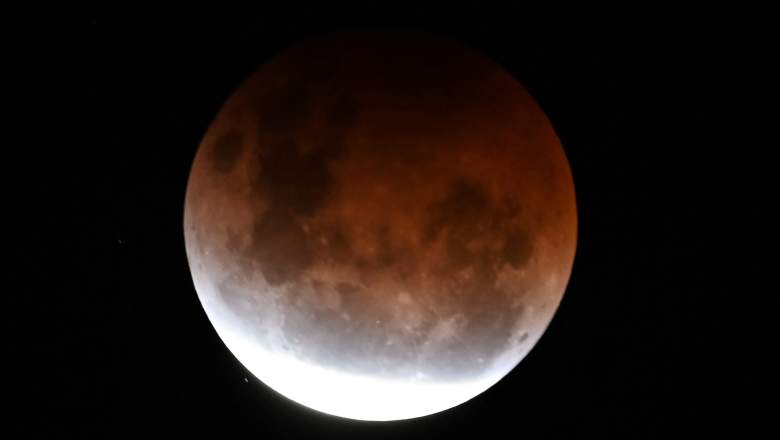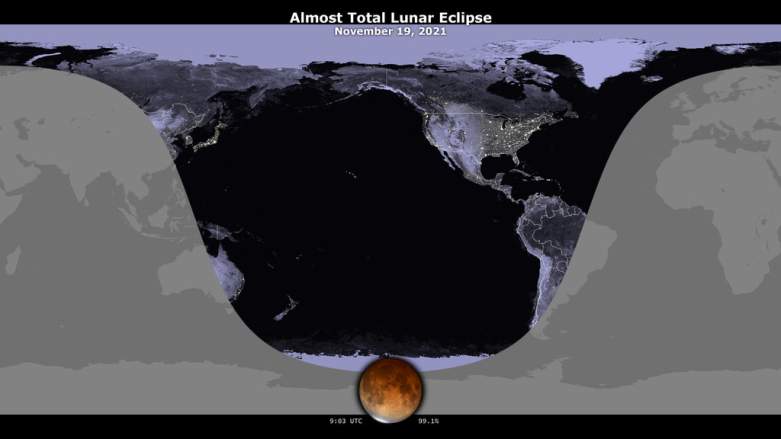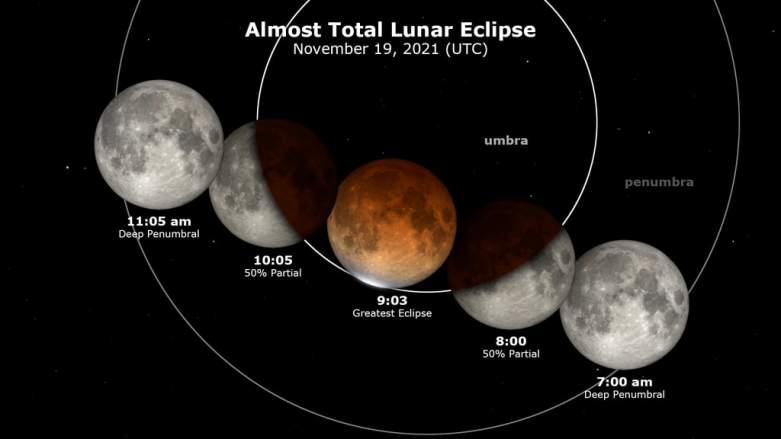
A partial lunar eclipse is happening in the early morning (or late night hours, depending on your time zone) tonight. This one will be visible in all of North America. Here are all the details you’ll need on where you need to be to see the partial lunar eclipse beaver moon, including a map of the path and visibility in the United States.
Here Is the Partial Lunar Eclipse’s Map & Path for Tonight
The partial lunar eclipse is happening late tonight (Thursday, November 18) or early in the morning on Friday, November 19, depending on your time zone. “Beaver moon” is the name given for the November full moon by Native Americans, signifying when beavers were most active preparing for winter, The Washington Post reported. The full moon in November is also sometimes referred to as the snow moon, frost moon, or frosty moon.
While there won’t be any moment of totality tonight, the moon will get about as close as totality as it can without being fully covered by the Earth’s shadow. The peak eclipse occurs at 4:03 a.m. Eastern/3:03 a.m. Central/2:03 a.m. Mountain/1:03 a.m. Pacific.
NASA has provided a map of the lunar eclipse’s path here. The map is also included below. NASA wrote about the map: “A world map showing where the eclipse is visible at the time of greatest eclipse. Earlier parts of the eclipse are visible farther east, while later times are visible farther west.”

NASAEclipse map.
NASA wrote about the above map:
On November 19 (late evening of the 18th in some time zones), the Moon passes into the shadow of the Earth, creating a partial lunar eclipse so deep that it can reasonably be called almost total. At the moment of greatest eclipse, at around 9:03 a.m. Universal Time, 99.1% of the Moon’s disk will be within the Earth’s umbra. This part of the eclipse is visible in all of North America, as well as large parts of South America, Polynesia, eastern Australia, and northeastern Asia.
You can see another map, from Time and Date, here. You can enter your location into that map to see exactly when the partial eclipse is where you live.
This next chart shows the eclipse’s progression.

NASAEclipse progression
NASA wrote about the above graphic: “The Moon’s appearance isn’t affected much by the penumbra. The real action begins when the Moon starts to disappear as it enters the umbra at about 7:20 a.m. UTC (2:20 Eastern Standard Time, 11:20 p.m. Pacific on the 18th). An hour or so after that, the part of the Moon still in sunlight will be small enough for observers’ eyes to adapt to darkness and perceive the coppery color of the part of the Moon within the umbra…”
What Time Can You Watch the Eclipse?
According to NASA, the entire progression begins at 1:02 a.m. Eastern and lasts until 7:04 a.m. Eastern. However, the partial eclipse portion itself begins at 2:19 a.m. Eastern through 5:47 a.m. Eastern, for a little more than three hours.
If you only want to see the peak of the eclipse, when the moon is up to 99.1% covered by the Earth’s shadow, that occurs at 4:03 a.m. Eastern. However, the part where the moon appears reddish in tone lasts from about 3:45 a.m. Eastern to 4:20 a.m. Eastern.
READ NEXT: Hallmark’s Christmas 2021 Lineup of Movies